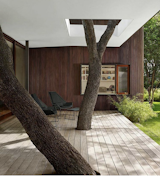23 Unconventional Homes Built Around Trees
Designing homes with nature in mind has become increasingly common, whether the focus is on sourcing sustainable construction materials or forging connections between the interior spaces and surrounding landscape. It comes with good reason: The benefits of having greenery in your home include reduced stress, better focus, and cleaner air. These 23 residences take things a step further by incorporating trees into the layout.
The Constant Springs Residence in Austin, Texas, is built around a pair of massive oak trees—one of which shoots through an ipe deck and into a void in the overhanging cedar roof. "The hole also allows light to penetrate deeper into the house," notes designer Kevin Alter, principal of Alterstudio Architecture.
Architect Joe Chikamori worked with a young couple in Kyoto, Japan, to create an open-plan home for their family with a double-height living room at the center. Since the compact site left little room for a backyard garden, the living area was developed as an interior courtyard situated around an indoor tree.
Local firm Atelier Vens Vanbelle renovated a decaying house in Ghent, Belgium, by gutting the multistory building, restoring the brick facade, and replacing the roof—then lowering a nearly 40-foot oak tree into the structure by crane. The home’s various levels were constructed in a spiral formation around the trunk to create an open interior space without walls in the living areas.
Part of an environmentally conscious glamping retreat in Dorset, England, this two-story tree house stands on high stilts to minimize its effect on the land. Inside, there’s a circular living room with a revolving fireplace, as well as a bedroom with a skylight, a bespoke kitchen, and an updated bathroom. The exterior deck includes an open-air shower and a spiral staircase that leads to the top level, where a hot tub and sauna await.
At architect Miguel Ángel Aragonés's Mexico City residence, angular, white walls enclose monochromatic outdoor living spaces that are tempered by an abundance of greenery. The house is part of a compound that includes a design studio office and two other residences that Miguel rents out for public events—or to people who want to stay "a day, a month, or a year."
When architect Jeremy Levine and his wife, Robin, remodeled their house in the Eagle Rock district of Los Angeles, they chose to keep it at the scale of other houses in the neighborhood. They expanded the back and front of the structure by building decks around existing trees on the site. A young, drought-tolerant Tristania conferta (also known as Australian brush box tree) grows up through the "chill-out room" under the deck at the rear of the house.
Architect Toan Nghiem of a21 Studio designed the Saigon House to merge Ho Chi Minh City’s typical architectural and stylistic details. Native trees are planted on the ground floor as well as on balconies and in the steel frames, covering the home with plants and bringing a piece of the natural world inside. A rear alleyway in the joint family home serves as a living and dining room, while an overhead netted area offers a playground for the children.
It’s not easy to transform a 15-foot-wide site (wedged between houses in every direction) into a home that feels spacious. Tokyo-based firm Mamm-design’s solution was to dedicate two-thirds of the 653-square-foot residence into a central garden room. The kitchen, bedroom, bath, and home office are all connected to a gray-brick terrace, which is anchored by an evergreen ash tree.
The Tatami House, designed by Swiss architect Roger Kurath of Design*21, features a Japanese maple in the central courtyard, following the traditional Japanese concept of bringing the outside scenery in. Because the tree had to be planted before the ipe deck was laid, Kurath designed a small, removable panel to allow the homeowners to tend to the tree and access its base.
Because the Lake View Residence’s building site in Austin, Texas, had a collection of mature trees that the clients wanted to preserve, the team at Alterstudio Architecture created cutouts in the deck and overhang. Mulch and living ground covers—including Big Blue liriope, marsilea, and Palisades zoysia turf—help retain moisture within the soil and lower its temperature to protect the roots of the property’s live oak trees.
What differentiates a house designed by architects from a woodland nest built by a robin or a rabbit? That question—and a desire to narrow the gap between the two— inspired the 1,300-square-foot dwelling that architect Keisuke Maeda designed for a teacher, her two teenage daughters, and their cat in the hills of Onomichi, on the southern end of the Japanese island of Honshu. "It’s a nest that’s dug into the ground and covered with fallen leaves, where inside and outside flow into each other," says Maeda. "That seemed right for a house near the woods."
Rather than utilizing a traditional frame construction, architect Jamie Darnell built his family’s home in Kansas City, Missouri, using SIPs (structural insulated panels) that came in four-by-eight-foot sections. With ladder-like steps leading to the front door, the house feels like a polished tree house. Jamie even constructed the ipe decking to accommodate an existing tree by the garage entrance.
Satoshi Saito of SAI Architectural Design Office took the directive to heart when a young Osaka family requested a home in which they could "feel green." The indoor/outdoor residence essentially comprises two structures that are unified by a double-height, courtyard-like space with clerestory windows that usher in ample natural light.
In Sunnyvale, California, architect Ryan Leidner transformed a 2,000-square-foot Eichler that was originally designed in the 1960s by A. Quincy Jones. "The atrium is the first place you enter," says Leidner. "Traditionally, it’s a hardscape area with some potted plants, but we wanted it to be more like a full garden, right in the middle of the house."
Related Reading:
Published
Last Updated
Topics
RoundupsGet the Dwell Newsletter
Be the first to see our latest home tours, design news, and more.






















